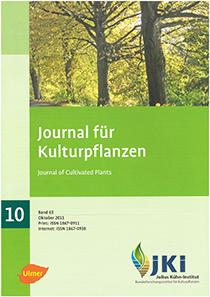SIMONTO-Lupin: an ontogenetic simulation model for lupin species (<em>Lupinus angustifolius</em>, <em>L. luteus</em> and <em>L. albus</em>)
DOI:
https://doi.org/10.5073/JfK.2011.10.03Keywords:
Lupin, temperature development rate, growth stages, ontogenetic modelAbstract
The development of the infection of Colletotrichum lupini is in addition to temperature and leaf wetness duration strongly dependent on the plant development stage (BBCH). For this reason a simple ontogenetic model (SIMONTO-Lupin) for the three lupin species Lupinus angustifolius, L. luteus and L. albus was developed and integrated into the decision support system SIMCOL which deals with the disease management of the pathosystem C. lupini – L. angustifolius. For the simulation of the crop stages a temperature development rate was modelled. Besides literature data about 180 data series from national variety and fungicide trials of blue, yellow and white lupin were used as data base for modelling SIMONTO-Lupin.
For the model validation 240 data sets of blue lupin of national variety and fungicide trials for the years 2006–2009 were available. These data sets were independent of the data sets used for model development.
The model SIMONTO-Lupin represents particularly the important period of flowering. The validation of the model (difference between observed and simulated growth stage max. 7 days) for the BBCH stage 61 (beginning flowering) showed 85% and for the stage 69 (full bloom) about 75% correct forecasts. Other validation criteria like the subjective validation showed about 88% correct forecasts. The validation by means of linear regression achieved, on average, a coefficient of determination of 0.984.
Published
Issue
Section
License
The content of the journal is licensed under the Creative Commons Attribution 4.0 License. Any user is free to share and adapt (remix, transform, build upon) the content as long as the original publication is attributed (authors, title, year, journal, issue, pages).
The copyright of the published work remains with the authors. The authors grant the Journal of Cultivated Plants, the Julius Kühn-Institut and the OpenAgrar repository the non-exclusive right to distribute and exploit the work.







